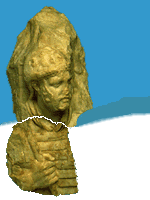

Exhibit Overview
 The
fragments were discovered in 1900 and 1901 during an urban development
project in the Piazza della Repubblica (formerly the Piazza di Termini),
the site of the ancient Baths of Diocletian in Rome. Two professors of
archaeology, Paul Hartwig and Francis W. Kelsey, acquired the sculptures
and donated them, respectively, to the Museo Nazionale Romano and the
University of Michigan museum later named in Kelsey's honor.
The
fragments were discovered in 1900 and 1901 during an urban development
project in the Piazza della Repubblica (formerly the Piazza di Termini),
the site of the ancient Baths of Diocletian in Rome. Two professors of
archaeology, Paul Hartwig and Francis W. Kelsey, acquired the sculptures
and donated them, respectively, to the Museo Nazionale Romano and the
University of Michigan museum later named in Kelsey's honor.
After almost a century of transatlantic separation, the 15 fragments were reunited in 1993 in Rome, where, in 1994, they were exhibited as an ensemble for the first time in the new Museo Nazionale Romano at the Palazzo Massimo, a few hundred meters from the place where they were found.
The sculptures date to the end of the first century AD, when the Flavian dynasty ruled the Roman Empire. This Flavian date and their place of discovery suggest that the fragments belonged to the Templum Gentis Flaviae (Temple of the Flavian Clan), a grandiose temple and tomb complex erected by the emperor Domitian to glorify his imperial family.
This exhibition presents the results of research that coupled the study and hypothetical partial reconstruction of the lost monument with a scientific program of conservation and replication. The latter produced a complete set of stunningly accurate casts while successfully safeguarding the ancient marble fragments.
The exhibition utilizes both ancient fragments and modern casts to explore historical and symbolic aspects of the Roman sculptures and to document the scientific techniques employed to create the replicas.
The highly mimetic casts are ultimately destined to be integrated with the original sculptures in their respective museums. Here they are used to realize the proposed reconstructions of the Templum Gentis Flaviae without committing the ancient fragments themselves to a hypothetical installation.
The exhibition also includes a series of photographs and illustrations that traces the urban development of the Piazza di Termini, where the sculptures were discovered.
A photographic sequence and videotape follow, step by step, the innovative replication process that produced the faithful casts, an operation carried out by the Istituto Centrale del Restauro in the Baths of Diocletian, the original site of the Museo Nazionale Romano delle Terme.
Copyright ©1997, 2002 Ministero per i Beni Culturali e Ambientali, Soprintendenza Archeologica di Roma and the Kelsey Museum of Archaeology, University of Michigan. All rights reserved.
 |
 |
 |
 |
 |
 |
 |
 |
 |